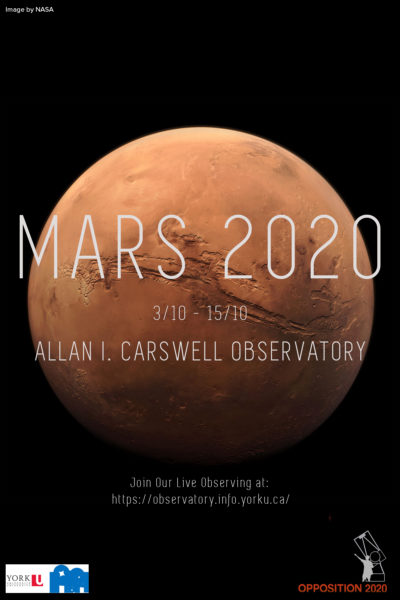TORONTO, Sept. 29, 2020 – Hyde, an assistant professor in the Faculty of Science, is available to discuss Mars opposition and the best way to see the red planet.
In addition, the public can tune into the Allan I. Carswell Observatory’s live event, including talks and real-time images of Mars through the one-metre telescope.
“During this event, Mars can be found in the constellation Pisces with a visible mag -2.7, this means it will be brighter than Sirius and brighter than Jupiter,” says Hyde. “In the weeks leading up to opposition, you can observe many different Martian features you may not otherwise see.”
 The observatory will show live telescope images to the public on its YouTube channel (https://www.youtube.com/user/YorkUObservatory/live) on Oct. 3 and 6, and from Oct. 11 to 15, from 8 to 10 pm, as long as the weather is clear. Students and volunteers will share information on what the telescope is showing.
The observatory will show live telescope images to the public on its YouTube channel (https://www.youtube.com/user/YorkUObservatory/live) on Oct. 3 and 6, and from Oct. 11 to 15, from 8 to 10 pm, as long as the weather is clear. Students and volunteers will share information on what the telescope is showing.
Want to use your own telescope? “A small scope will show the larger markings, while anything over 200mm starts to reveal more detail,” says Hyde.
On Oct. 3, the last close conjunction of Mars and the Moon for 2020, the Moon will almost be full, and Mars will be very bright. The York observatory will show images of both that night. The best view will be on Oct. 6 when Mars is at its closest; while it’s a bit further away come Oct. 13, it will still be brighter than usual.
What features will you see?
- Areas of light and dark, representing deserts and exposed rock.
- Albedo features: areas that appear bright or dark due to the amount of light they reflect. The larger and darker an albedo feature, the easier it is to see through a small telescope.
- The most prominent dark feature is the V-shaped form of Syrtis Major, a low-level shield volcano. When it has rotated into view, the ‘point’ of Syrtis Major points north, appearing to extend quite far toward the northern edge of Mars during the 2020 opposition.
- West of Aurorae Sinus is the “Eye of Mars,” the central feature being dark Solis Lacus. The immense Vallis Marineris canyon lies northeast of Solis Lacus.
- The desert expanses of Tharsis and Amazonis lie northwest of the “Eye of Mars.” Here three volcanic peaks named (north-to-south) Ascraeus Mons, Pavonis Mons and Arsia Mons define the southwest edge of the “Tharsis quadrangle.”
- Arranged in a line, they look northwest over the vast volcano Olympus Mons. Bright orographic clouds may form when the Martian atmosphere is forced upward over these volcanoes.
- Between the southern boundary of Syrtis Major and the southern polar cap lies the Hellas Basin. This 2,300 km diameter basin is one of the largest impact craters in the Solar System. Hellas can sometimes appear bright due to clouds that form in the basin.
In addition, there will be a Mars-themed Online Public Viewing Monday, Oct. 12 and a Mars-themed YouTube live TeleTube Wednesday, Oct. 14. For details, visit the observatory website. (https://observatory.info.yorku.ca/)
-30-
York University champions new ways of thinking that drive teaching and research excellence. Our students receive the education they need to create big ideas that make an impact on the world. Meaningful and sometimes unexpected careers result from cross-disciplinary programming, innovative course design and diverse experiential learning opportunities. York students and graduates push limits, achieve goals and find solutions to the world’s most pressing social challenges, empowered by a strong community that opens minds. York U is an internationally recognized research university – our 11 faculties and 25 research centres have partnerships with 200+ leading universities worldwide. Located in Toronto, York is the third largest university in Canada, with a strong community of 53,000 students, 7,000 faculty and administrative staff, and more than 300,000 alumni. York U's fully bilingual Glendon Campus is home to Southern Ontario's Centre of Excellence for French Language and Bilingual Postsecondary Education.
Media Contact:
Sandra McLean, York University Media Relations, 416-272-6317, sandramc@yorku.ca

